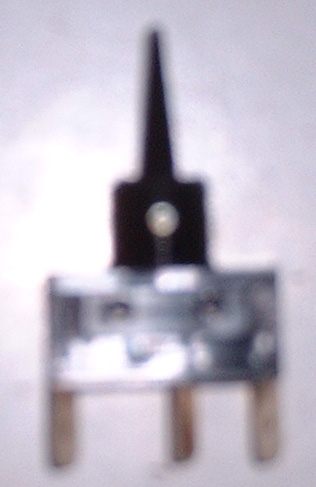First of all, you should understand the basic physical varieties of switches:
Rocker switches are the kind which you "rock" back and forth. Slide switches are similar, except they slide instead of rocking. Flip switches usually have a lever-like protrusion which you flip back and forth.
Push-button switches are pretty self-explanatory. Unlike other switches, push-button switches do not provide easy recognition of what state the switch is in; Rocker or flip switches rest in a particular position, and you can see at a glance where they are. A push-button switch is limited to being slightly more pushed-in in one state than the other, which isn't as easy to notice. Some push-button switches will stay pushed-in when you push them, and need to be pushed again to make them pop back out. They toggle between "on" and "off" whenever you push them. The power buttons on most stereo systems are examples of this kind of button. Others will stay in only as long as your finger is on them, and pop out as soon as you release them. These are called momentary switches. A doorbell is an example of a momentary push-button switch.
You should also understand the concepts of poles and throws, including SPST (Single-Pole, Single-Throw), SPDT (Single Pole, Double-Throw), DPST (Double-Pole, Single-Throw), and DPDT (Double-Pole, Double-Throw) switches. A pole is a contact to the switch mechanism that is always connected. On the other hand, a throw is a contact which can be switched to/from.
As an example, take a look at this switch:

When this switch is flipped to the left, the left contact is joined with the center contact. When this switch is flipped to the right, the right contact is joined with the center contact. Notice that the center contact is always connected, but the left and right ones can be switched. The center contact is a pole, while the other two are throws. Thus, this is an SPDT switch. It is also worth mentioning that because this switch can alternately be moved to the center so that neither the left nor the right side is connected to the center, this is a center-off SPDT switch. It is important to understand that this is NOT a double-throw switch because the switch can be in three separate positions. Many SPDT switches do not have an "off" position, but simply switch the pole between one throw or the other. Such switches can only be in two positions (not three like the one in this photo), but they are still SPDT switches. They just are not center-off ones.
(Yes, I know the photo is horribly blurry. Blame my camera. If somebody wants to send me a better photo of a profiled SPDT switch, please do so.)